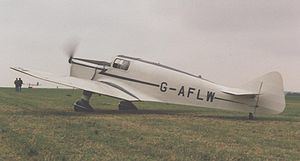Top speed 233 km/h Length 7.92 m Manufacturer Miles Aircraft | Wingspan 11 m First flight February 21, 1938 | |
 | ||
The Miles M.17 Monarch was a British, light, touring aeroplane of the 1930s. It was a single-engine, three-seat, cabin monoplane with a fixed, tailwheel undercarriage.
Contents
Development
The last civil type produced by Phillips and Powis before the war, the Monarch was a development of their earlier Whitney Straight. Compared to its sibling. the Monarch had an enlarged fuselage, allowing provision of a third seat in part of what had been the luggage space.
Operational history
Eleven aircraft were built between 1938 and 1939, six of these to British customers, the rest going to export.
On the outbreak of war five of the British-registered machines were impressed by the Air Ministry; one machine belonging to Rolls-Royce acquired camouflage paint but remained in its owner's service. All but one of these survived the war, though a Dutch-registered aeroplane (PH-ATP) was destroyed in the Luftwaffe raid on Schiphol on 10 May 1940. One aircraft, OY-DIO, was on the Danish register until Sept. 9, 1939 and owned by a Dane named Hagedorn.
In the 1950s, one Monarch (G-AIDE) enjoyed some success as a racer in the hands of W.P. Bowles
For the most part, the remaining Monarchs led uneventful but useful careers; a number survived into the Sixties. G-AFJU is displayed at the National Museum of Flight at RAF East Fortune near East Linton, Scotland.
Sporting successes (G-AIDE)
Operators
Specifications (M.17)
Data from British Civil Aircraft 1919–1972: Volume III
General characteristics
Performance
